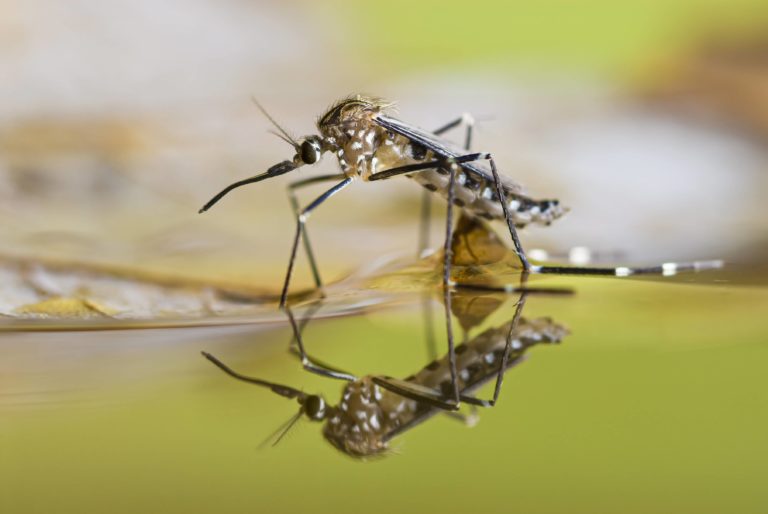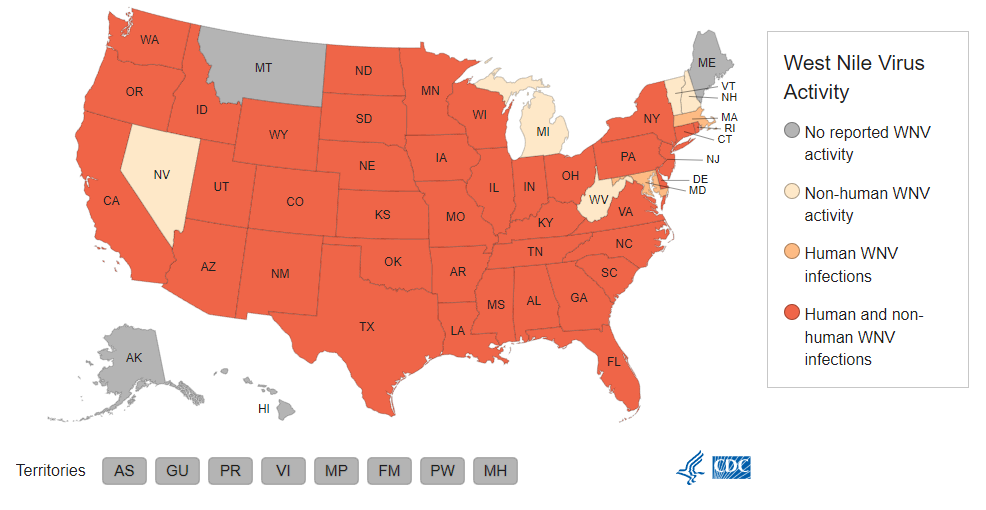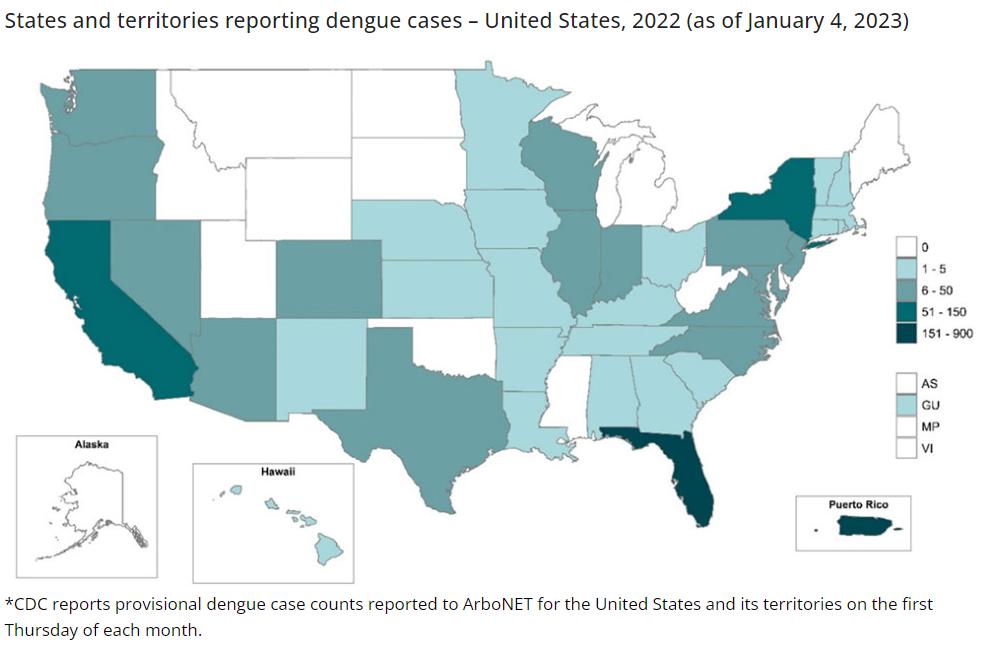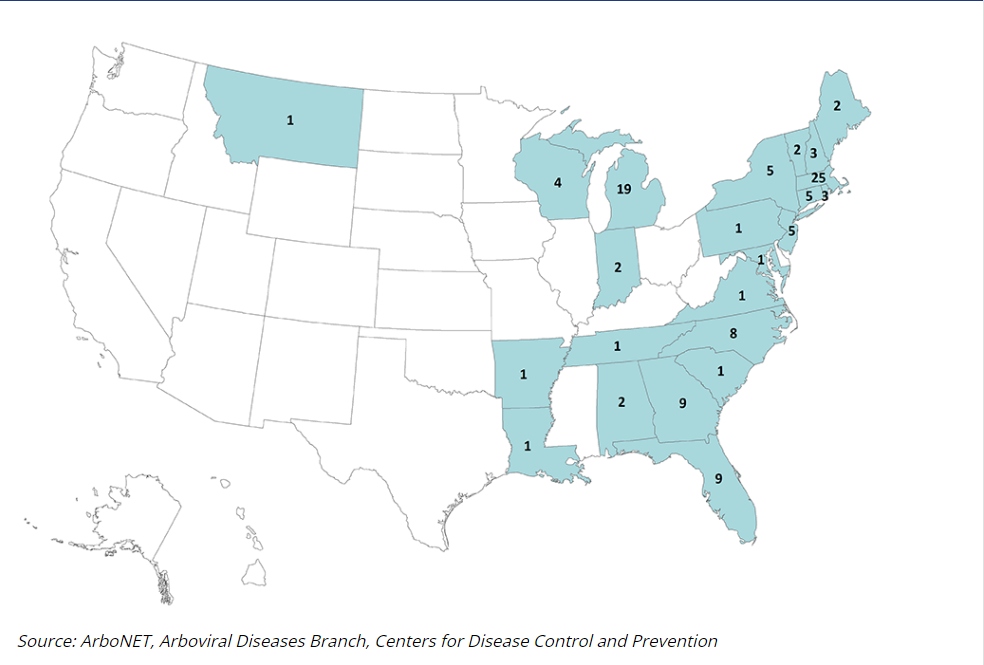With COVID-19, an ongoing “tripledemic” of multiple respiratory diseases, the economy, and politics dominating the headlines in 2022, vector-borne diseases didn’t get much attention in the national spotlight. However, diseases spread by mosquitoes and ticks are on the leading edge of increasing concerns about climate change, and the experts at VDCI continue to monitor their activity so we can keep the public and our clients informed.
This year in review looks at major mosquito-borne diseases in the United States, summarizes case counts in 2022, and highlights key areas of activity. As we kick off a new year, these data points can inform and shape your integrated mosquito management plans, as well as give you information to provide to your citizens, employees, customers, and the public at large to help them protect themselves and their families from mosquito-borne disease.
West Nile Virus
2022 US Case Count: 1,035 human cases; 79 deaths
West Nile continues to be the deadliest mosquito-borne disease in the continental U.S. First reported in 1999, the virus is now considered endemic by public health authorities in most areas.
There are an estimated 200 species of mosquitoes found in the United States; of those, approximately 150 can be vectors of West Nile virus (WNv). Species of the Culex genus are considered to be the primary carriers of the disease both globally and in the U.S., with Culex pipiens, Culex tarsalis, and Culex quinquefasciatus being the primary species that spread West Nile virus in the U.S.
Humans contract WNv when bitten by an infected mosquito. While even healthy adults can contract the disease, West Nile can be especially dangerous for the very young and the very old, as well as anyone with a compromised immune system. Many infected people have no symptoms; however, those that do may have flu-like symptoms, fever, rash, neck stiffness, and headache. For some infected individuals, the disease can be more severe and lead to encephalitis, or swelling of the brain, and be fatal. The U.S. Centers for Disease Control and Prevention (CDC) estimate that 1 in every 150 cases of West Nile lead to the central nervous system being affected, and the onset of neuroinvasive disease. These cases become more severe and can leave people with long-lasting or permanent neurological symptoms.
In 2022*, there were 1,035 human cases of West Nile reported by the CDC in the U.S., with 298 being qualified as neuroinvasive disease. There were 79 fatalities as a result of the disease. Both human cases and deaths from WNv were significantly down from 2021, but since the disease is cyclical, the drop in case counts does not indicate that there is less reason for concern, and some regions of the country reported significantly higher case counts than they’ve ever seen.
Nearly every U.S. state faced West Nile virus, with only 4 reporting no activity of any type: Alaska, Hawaii, Maine, and Montana. None of the 8 reporting U.S. territories had West Nile activity, non-human, or human infections.
States with the highest incidence of human West Nile virus cases
Colorado (204)
California (168)
New York (79)
South Dakota (66)
Nebraska (64)
States with the highest West Nile virus death toll
Colorado (18)
California (11)
Texas (7)
Louisiana (6)
Nebraska (4)
Arizona (4)
Illinois (4)
Get more information on this mosquito-borne disease on our West Nile virus page. If you are concerned about West Nile virus in your community or around your business, connect with us to speak with one of our experts.
Dengue
2022 US Case Count: 1073 human cases, 0 deaths
Dengue is a group of viruses spread to humans by infected Aedes genus mosquitoes, specifically Aedes aegypti and Aedes albopictus; pregnant people can also pass the disease to a fetus. There are 4 common Dengue viruses, denoted as Dengue 1, 2, 3, and 4. Worldwide, there are over 400 million cases annually, and an estimated 40,000 people die each year.
According to the CDC, public health authorities in the United States reported a total of 1,073 cases of Dengue this year. However, the vast majority of those cases were travel-acquired, meaning that the subjects were infected outside of the U.S. Only 59 cases were considered locally transmitted. There were no reported fatalities in the country as a result of Dengue, although this may reflect underreporting.
U.S. territories Guam and Puerto Rico reported a combined total of 828 cases. Unlike the continental U.S., nearly all of these cases in the territories were locally acquired – 820, to be exact. This is not surprising, given the more tropical conditions, and vector abundance in these locales.
One significant development that is worth noting: in 2022, the Dengvaxia vaccine was approved for use in the United States in children august 9 to 16 with laboratory-confirmed results of a previous Dengue infection.
The U.S. case counts in 2022 illustrate a substantial increase in reported cases over both 2021 and 2020, but a slight decrease versus 2019. This could be a reflection of an increase in the traveling public in 2022, since there was a significant post-pandemic return-to-travel. 2019 marked the highest number of Dengue cases reported in the U.S. since 2010 when it became a reportable disease and case counts began being tracked. That makes 2022 the second-highest case count reported in U.S. states in the last 12 years.
This could be an interesting trend to watch around the globe. According to the Pan American Health Organization, in 2022, a number of countries in North, Central, and South America saw substantial increases in human Dengue cases over 2021.
Americas (North, South, Central), 5 countries with highest increases in Dengue human cases
Country | 2021 Dengue Cases | 2022 Dengue Cases | Percentage Increase |
United States | 117 | 1073 | ⬆️817.094% |
Panama | 3095 | 11172 | ⬆️260.969% |
El Salvador | 5572 | 16542 | ⬆️196.877% |
Guatemala | 2861 | 8407 | ⬆️193.848% |
Nicaragua | 36741 | 97541 | ⬆️165.483% |
The World Health Organization (WHO) tracks Dengue activity around the globe and in early January 2023, issued an update on Dengue in the Western Pacific Region, indicating that activity has substantially increased in many countries including Lao, Malaysia, the Philippines, Singapore, and Viet Nam.
Get more facts and information about Dengue virus from VDCI.
La Crosse Virus Disease
2022 US Case Count: 21 human cases
La Crosse virus is typically spread by Aedes triseriatus, commonly called the Eastern treehole mosquito. This disease most commonly affects children and teenagers.
La Crosse virus disease is endemic in the United States and is considered a reportable illness.
Symptoms of La Crosse virus are similar to those of other mosquito-borne diseases and include fever, headache, nausea and vomiting, and fatigue. However, it can become dangerous if it becomes La Cross encephalitis, which results in infection of the brain that can manifest through seizures, disorientation, loss of vision, and other serious conditions. Fatalities are rare.
Although the CDC’s La Crosse virus website does not reflect case counts after 2020, the agency’s Arbovirus Surveillance System, ArboNet, reports that there were 21 infections in 2022. More than half of these cases were reported in Ohio. The total number of cases is down from 2021, when 34 cases were reported.
U.S. states reporting La Crosse virus cases in 2022
State | Case Count |
Minnesota | 3 |
North Carolina | 2 |
Ohio | 13 |
Tennessee | 2 |
West Virginia | 1 |
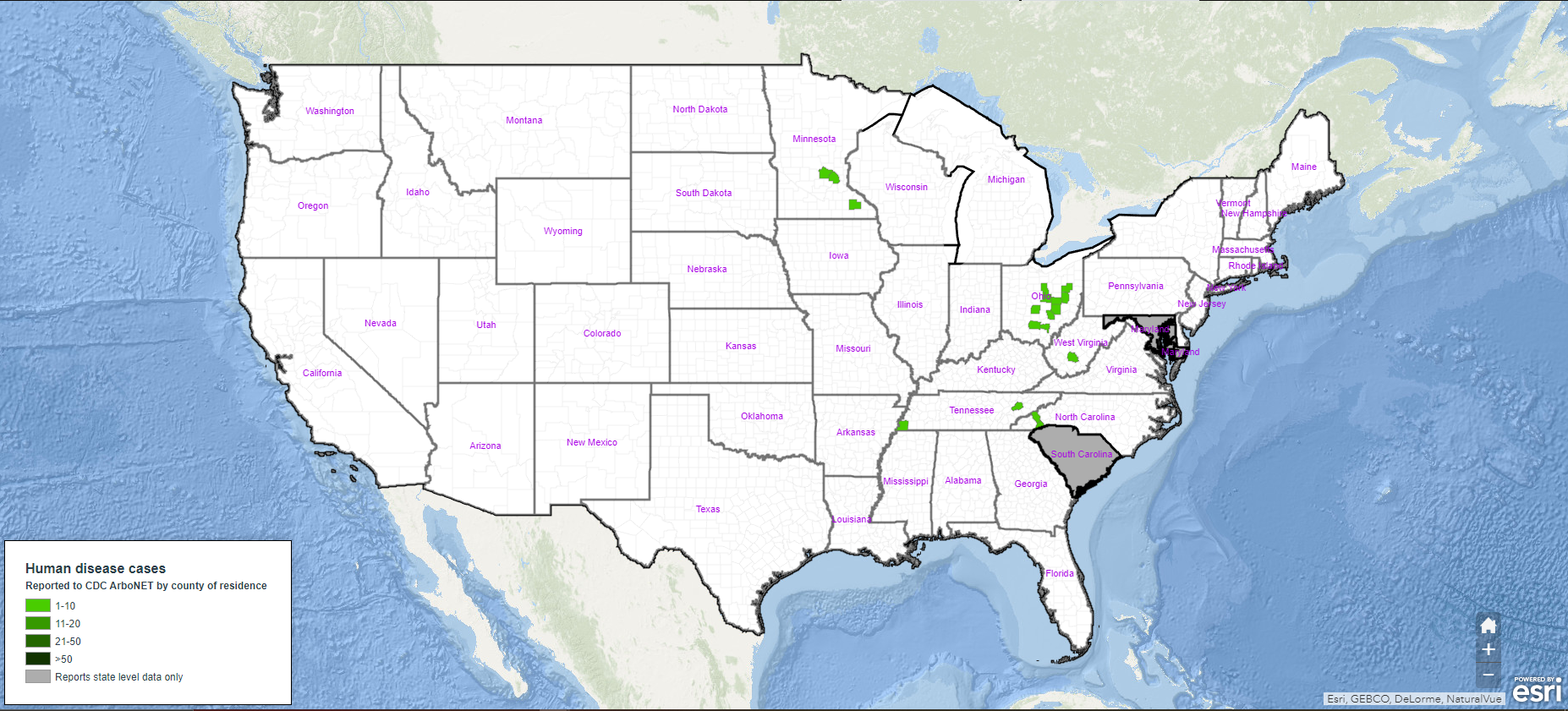
Eastern Equine Encephalitis (EEE)
2022 US Case Count: No reporting available
While rare, Eastern Equine Encephalitis (EEE) is a mosquito-borne disease that can affect both humans and some animals. While it is propagated between birds and the mosquito species Culiseta melanura, it is spread to humans and animals by species in the Aedes, Coquillettidia, and Culex genera that feed on infected birds and then mammals.
As its name suggests, horses are especially susceptible to the disease. Other animals that can become infected with EEE virus (EEEv) include pigs, rodents, and certain species of deer. Scientists believe that humans who contract and recover from EEEv have lifelong immunity against re-infection.
Approximately 4 – 5% of human EEEv infections lead to contracting Eastern Equine Encephalitis (EEE), which results in swelling of the brain. EEE has a very high mortality rate, with about one-third of those infected succumbing to the disease.
From 2011 – 2020, only 110 human cases of EEEv have been reported in the United States. In 2019, several outbreaks sparked concern and resulted in 38 human cases and 19 deaths, the highest number of deaths reported in a single year from the disease.
As the map below illustrates, these EEEv infections occurred primarily on the East Coast of the U.S., with high concentrations in New England, the Southeastern U.S., and the state of Michigan.
The CDC has not reported on EEEv infections since 2020. However, the U.S. Department of Agriculture’s Animal and Plant Health Inspection Service (APHIS) reported 110 animal cases in 2021. No data is available yet for 2022.
Learn more about EEE and EEEv on VDCI’s Eastern Equine Encephalitis resource page.
Chikungunya virus
2022 U.S. Case Count: 47 human cases (travel acquired)
Chikungunya virus was rarely discussed in the United States prior to 2006, but as global travel increased and climate shifts have occurred, more U.S. citizens have had experiences with Chikungunya in recent years. It is prevalent in the Caribbean, and while most cases remain travel-acquired, documented local transmission first occurred in 2013. Since 2015, Chikungunya has been a reportable illness in the U.S., which means that health officials are required to report any cases.
Spread to humans via the bite of an infected Aedes genus mosquito, particularly Aedes aegptyi or Aedes albopictus, Chikungunya virus infection can leave those infected with symptoms such as fever, joint pain and swelling, muscle aches, headaches, and more; joint pains are one of the most prominent symptoms and can last for months after the virus subsides. Fatalities are rare.
The CDC has not updated its Chikungunya reporting site since 2020, however, through the agency’s National Arbovirus Surveillance System ArboNet website, VDCI notes that 47 cases of the disease were reported by states in 2022. All of these cases were travel acquired. These cases were reported in 21 states, as reflected in the table below.
U.S. states reporting travel-acquired Chikungunya virus cases in 2022
State | Case Count |
California | 4 |
Colorado | 3 |
Illinois | 8 |
Iowa | 3 |
Kansas | 1 |
Kentucky | 1 |
Louisiana | 1 |
Massachusetts | 2 |
Minnesota | 1 |
New Hampshire | 1 |
New Jersey | 1 |
New Mexico | 1 |
New York | 5 |
North Carolina | 3 |
Ohio | 2 |
Pennsylvania | 2 |
Tennessee | 2 |
Utah | 1 |
Vermont | 1 |
Virginia | 3 |
Washington | 1 |
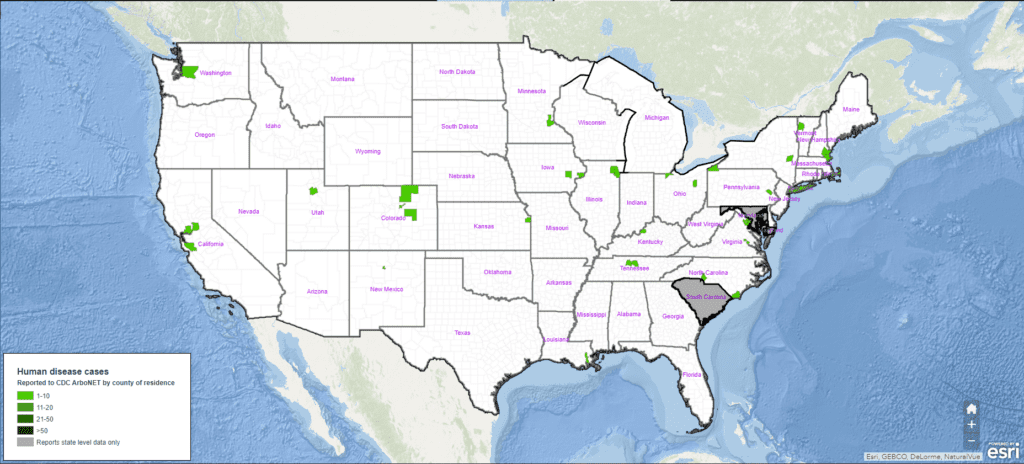
In 2021, there were 21 reported travel-acquired cases, so 2022 reflects a 123% increase in overall case counts over the previous year. As with the increase in Dengue, this may reflect a more global trend that is the result of a return to travel post-pandemic.
You can learn more about Chikungunya virus, its history, and its symptoms on VDCI’s resource page.
Zika Virus
2022 U.S. Case Count: 3 human cases (travel acquired)
Like Chikungunya virus, Zika virus has only recently become a significant concern in the United States. But, after significant tropical outbreaks in 2015 and 2016, locally acquired cases were reported in southern states such as Florida and Texas with much media attention, putting the disease on the map in the U.S. with health authorities and the public at large alike.
While Zika virus is spread primarily through the bite of infected Aedes genus mosquitoes, especially Aedes aegypti and Aedes albopictus that are found prevalently in the U.S., it can also be spread through sexual activity, which means that someone does not need to be bitten by a mosquito to be infected. This disease carries special risks for pregnant people who become infected. Zika virus can be passed to a fetus by the mother and result in birth defects and abnormalities.
In 2022, the CDC’s ArboNet system had no reports of locally transmitted Zika virus, but 3 travel-acquired cases were reported in the states listed below. This is a slight decrease from 2021 when 4 cases were reported.
U.S. states reporting travel-acquired Zika virus cases in 2022
State | Case Count |
Illinois | 1 |
Kentucky | 1 |
New York | 1 |
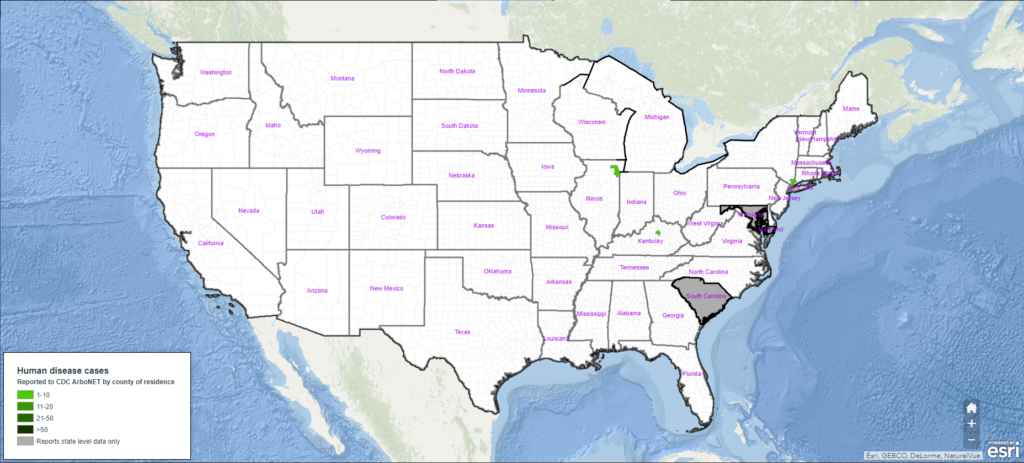
While these case counts are low, there is no way to predict when the U.S. could see a spike in activity like it did in 2015 and 2016. It is important for community leaders to help citizens understand the risks associated with Zika virus and to report any Zika symptoms to their doctors, especially if they or someone they are close with has recently traveled to an area where Zika virus is prevalent. It is also critical that individuals understand the risks and take action to protect themselves, especially while traveling.
Find out more about Zika virus, symptoms, and mosquito-bite protection on VDCI’s vector-borne disease resource website.
Other vector-borne diseases of concern
While this year-in-review focuses on 6 major mosquito-borne diseases, there are others that remain a source of concern in the U.S., including malaria, St. Louis Encelphalitis and Jamestown Canyon virus. And let’s not forget heartworm, which is spread by infected mosquitoes to our beloved pets.
There are also other vector-borne diseases, which encompass viruses and illnesses spread by other pests, such as rodents, ticks, and fleas. These include some common conditions that most people are familiar with, such as Lyme disease, and lesser-known diseases such as hantavirus, plague, Rocky Mountain Spotted fever, Powassan virus, and more.
Protecting your community from mosquitoes
Whether you are responsible for mosquito programs in your community or concerned about mosquito activity on your business property, having an in-depth knowledge of integrated mosquito management programs is critical to protecting those under your care from mosquito-borne disease.
VDCI is committed to mosquito surveillance and disease monitoring, developing robust integrated mosquito management programs for our clients, and educating the public on measures to protect themselves from vector-borne diseases. We also offer emergency response and drone and aerial application services to assist communities in preventing disease, especially following major weather events such as hurricanes and flooding.
If we can assist you or your community in mosquito prevention, please connect with us online or call (866) 977-6964.
*Results reported to U.S. Centers for Disease Control and Prevention as of January 12, 2023.
The key to limiting the spread of mosquito-borne diseases is monitoring and prevention. Municipalities and mosquito abatement districts often execute Integrated Mosquito Management (IMM) programs to help protect communities, but private citizens can support these efforts and empower themselves with disease tracking tools like the CDC’s ArboNet map. The map provides a live overview of reported mosquito activity and the most common vector-borne diseases, including:
- West Nile Virus (WNV)
- St. Louis Encephalitis (SLE)
- Eastern Equine Encephalitis (EEE)
- La Crosse (LAC)
- Dengue (DEN) locally-acquired and travel-associated
- Chikungunya (CHIK) locally-acquired and travel-associated
- Zika Virus (ZIKA) locally-acquired and travel-associated
*ArboNet is designed to reflect real-time information, but there are times when it may not be in sync. This resource is easy to navigate and can be sorted by disease type, state, and year.
 In addition to staying informed about the risks posed by mosquitoes in your community, it’s important to observe any travel warnings issued by the CDC, particularly when pregnant. It’s also essential to exercise personal protection measures like wearing insect repellent and exercising best practices around your property to reduce mosquito reproduction.
In addition to staying informed about the risks posed by mosquitoes in your community, it’s important to observe any travel warnings issued by the CDC, particularly when pregnant. It’s also essential to exercise personal protection measures like wearing insect repellent and exercising best practices around your property to reduce mosquito reproduction.
VDCI is committed to public education and spreading awareness throughout the U.S. about the dangers of mosquito-borne diseases and their preventability, with the overarching goal of reducing illness and fatalities. Our dedicated and experienced team works tirelessly with local governments to prevent the spread of mosquito-borne diseases in all of the contracts we service from coast to coast.
VDCI Wants To Make Your Community Safer. How Can We Help?
Speak to an expert about implementing an IMM program.
Fill out the information below, and one of our experts will follow up with you shortly.
 Since 1992, Vector Disease Control International (VDCI) has taken pride in providing municipalities, mosquito abatement districts, industrial sites, planned communities, homeowners associations, and golf courses with the tools they need to run effective mosquito control programs. We are determined to protect the public health of the communities in which we operate. Our mosquito control professionals have over 100 years of combined experience in the field of public health, specifically vector disease control. We strive to provide the most effective and scientifically sound mosquito surveillance and control programs possible based on an Integrated Mosquito Management approach recommended by the American Mosquito Control Association (AMCA) and Centers for Disease Control and Prevention (CDC). VDCI is the only company in the country that can manage all aspects of an integrated mosquito management program, from surveillance to disease testing to aerial application in emergency situations.
Since 1992, Vector Disease Control International (VDCI) has taken pride in providing municipalities, mosquito abatement districts, industrial sites, planned communities, homeowners associations, and golf courses with the tools they need to run effective mosquito control programs. We are determined to protect the public health of the communities in which we operate. Our mosquito control professionals have over 100 years of combined experience in the field of public health, specifically vector disease control. We strive to provide the most effective and scientifically sound mosquito surveillance and control programs possible based on an Integrated Mosquito Management approach recommended by the American Mosquito Control Association (AMCA) and Centers for Disease Control and Prevention (CDC). VDCI is the only company in the country that can manage all aspects of an integrated mosquito management program, from surveillance to disease testing to aerial application in emergency situations.


